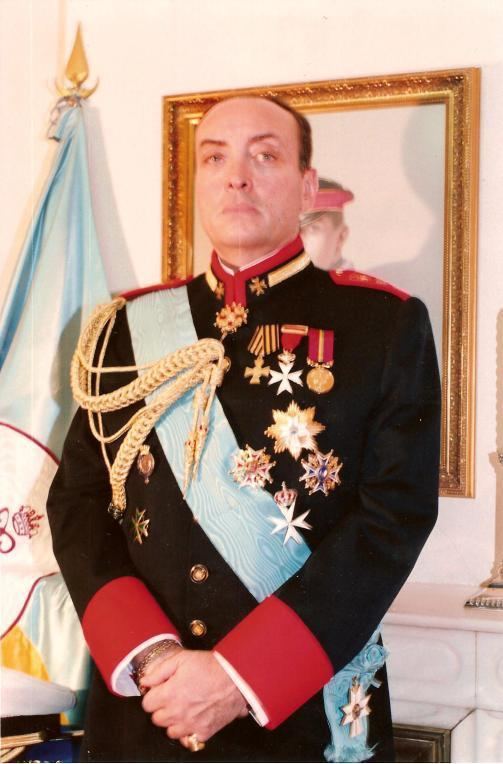Name Alexis Brimeyer | Died 1995 | |
 | ||
Parents Beatrice Czapska, Victor Brimeyer | ||
Alex Ceslaw Maurice Jean Brimeyer (1946–1995) was a false pretender who claimed connection to various European thrones. He used fraudulent combined titles like Prince d'Anjou Durazzo Durassow Romanoff Dolgorouki de Bourbon-Conde. He also sold false titles of nobility through "orders" he and his associates had created.
Contents
- Early life
- Noble Pretender
- Khevenhller Trial
- I Alexis Great Grandson of the Tsar
- Ties to the House of Cond
- Ties to Russia
- Serbian Throne
- Death
- References
Early life
Alex Brimeyer was born on 4 May 1946 in Costermansville (now Bukavu, Democratic Republic of the Congo). His parents were the engineer Victor Brimeyer and his wife Béatrice Difonzo.
Noble Pretender
Brimeyer's first attempt to ennoble himself came when he named himself, Brimeyer de la Calchuyére, in the 1950s when he was about ten years old. This came to nothing. In 1955, he took a name, His Serene Highness Prince Khevenhüller-Abensberg, but the real Princess Khevenhüller threatened to sue him. He backpedaled and apologized. Brimeyer also wrote to a number of aristocrats to convince them to adopt him. In 1969, he received a passport of the Principality of Sealand with the name His Highness Prince Alexis Romanov Dolgorouki. When he contacted a Brussels Orthodox priest, Jean Maljinowski, to be baptized, the priest was suspicious since the supposed prince did not speak a word of Russian.
He commissioned two death certificates to be published in Le Soir. Through them, he claimed that Nikolai Dolgorouki, his supposed father, had used a pseudonym of Nicholas di Fonzo to escape the October Revolution and lived under the name. In actuality, the Bolsheviks executed the real Nikolai Dolgorouki after the Revolution.
Khevenhüller Trial
Princess Khevenhüller-Abensberg, Maria Dolgoroukov and Prince Alexander Pavlovich Dolgorouki sued Brimeyer. They charged that Brimeyer was using their noble titles with malicious intent. The prosecutor presented a large number of fraudulent documents, including letters where Emperor Charles V supposedly ennobles Brimeyer. The court noted that his claim of marriage between his "grandfather", Prince Dolgorouki, and his "grandmother", Maria Nikolaevna (who had supposedly survived the execution of the Romanov family in July 1918), was false. On 24 November 1971 Brimeyer was sentenced to jail for 18 months but had fled to Greece from where he sent a letter to the prosecutor. In it he claimed descent from such luminaries as Emperors of Byzantium.
In Greece Brimeyer presented himself in the police station, and said that his passport had been stolen. He requested temporary documents. He registered then himself as Alexis Romanov Dolgorouki and for the next ten years he used those documents to "prove" his status.
"I, Alexis, Great Grandson of the Tsar"
In 1979 Brimeyer was living in Spain and contacted the cadet line of the Anjou Durassos. He convinced some of them to give their support and recognize him as the head of the royal house of Anjou-Durazzo. 1982 he published a book "I, Alexis, Great Grandson of the Tsar" by "H.R.H. Prince Alexis d'Anjou Romanov-Dolgorouki, Duke of Durazzo". The book included a "will" where Vassili d'Anjou Durassow supposedly recognized him as his only son. Thus he claimed connection to the house of Anjou and the throne of Naples.
Alexis was certain that Victor Brimeyer was not his father. He claimed that after his mother divorced Brimeyer she married Vassili d'Anjou Durassow on 15 April 1947 and that he was born in 1948. This supposed marriage was then annulled and she married Prince Igor Dolgorouki on 6 September 1946. Note that she married Farby two years later. The couple had been elected as royal rulers of Ukraine but had to resign in 1939.
Ties to the House of Condé
In August 1984 Alexis' mother, "Princess Olga Beatrice Nikolaevna Romanovskaia Dolgoroukaia, Princess of the Ukraine, Countess di Fonzo", married Major General Bruce-Alfonso de Bourbon, Prince of Condé, or more simply, Bruce Conde. After the wedding, he adopted Brimeyer. This gave Alexis an excuse to add the title Bourbon-Condé.
Ties to Russia
Next, Alexis claimed that as his father was the son of Prince Dolgorouki and that Prince Dolgorouki had married the supposedly escaped Grand Duchess Maria Nikolaevna of Russia, and that his mother was their only daughter. Alexis claimed that his grandfather had been elected Volodar of Ukraine and persuaded a few orthodox priests that he was the heir to a throne. Through the Grand Duchess, Alexis claimed a connection to the Romanovs and the Russian throne.
Serbian Throne
He sent numerous letters to King Juan Carlos of Spain and demanded his recognition. He married and had a son. He also managed to convince the British College of Arms to include himself in documents. Lord Mountbatten of Burma wrote to him on 3 January 1977, addressing him as Prince Dolgorouky as a courtesy.
In 1992, two Greater Serbian nationalists, including Vojislav Šešelj, visited Brimeyer in Spain. Supposedly they offered him the throne of Serbia. He told journalists that he had been in touch with Slobodan Milošević, who was supposedly in favor of restoring the Serbian monarchy. Then he used the title, "Prince Alexis II Nemanitch Romanov Dolgorouki", Grand Master of the Order of Saint John of Jerusalem. He had convinced his Serbian nationalist supporters that he was descended, in a very convoluted manner, from Hrebeljanovic Nemanitch.
Alexis claimed to have accepted the throne of Serbia. There appeared to be at least some support for him. The European Monarchist Association published a communiqué, where it stated Brimeyer's real identity. The scheme then appears to have collapsed.
Death
Alexis Brimeyer died of AIDS in Madrid in March 1995. Some of his supporters continue to run his affairs.
